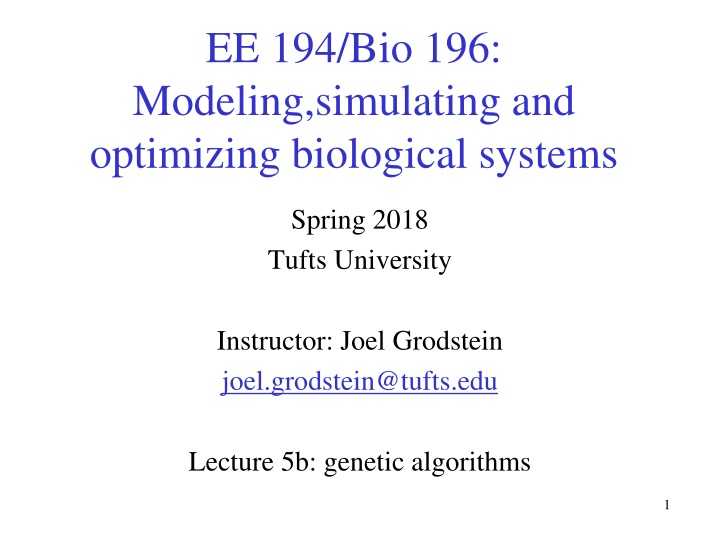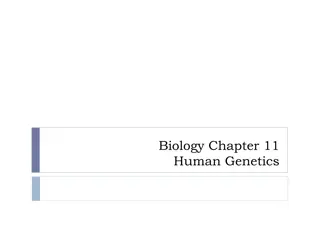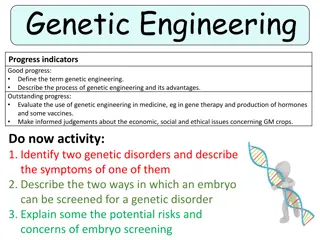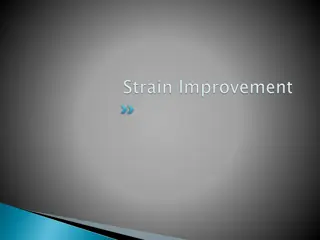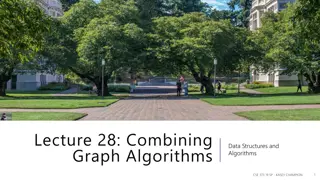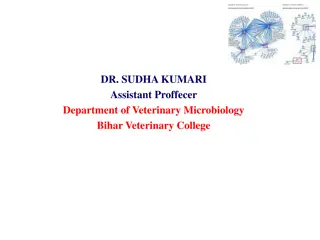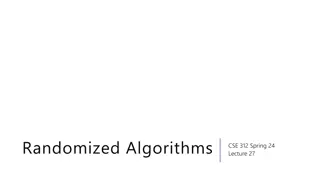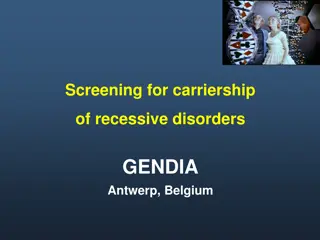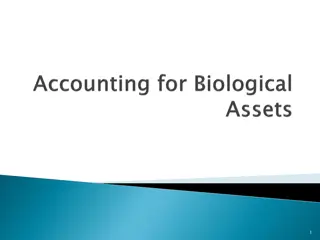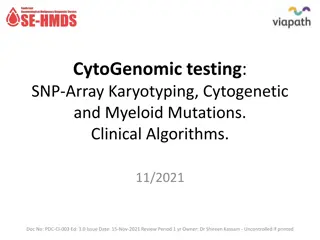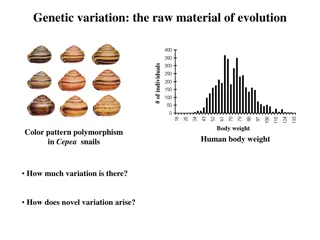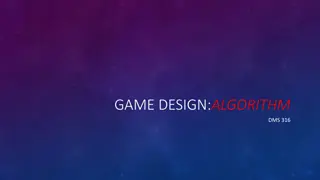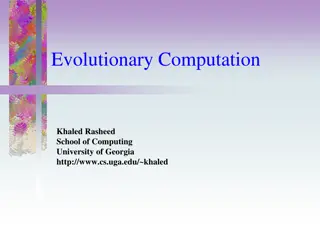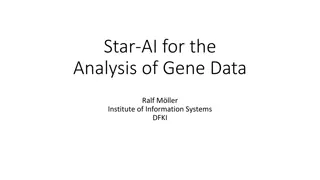Genetic Algorithms: Modeling and Optimizing Biological Systems
Explore the concept of genetic algorithms in the context of modeling and optimizing biological systems, as discussed in the lecture by Joel Grodstein at Tufts University. The content delves into the challenges of optimization, the immense number of potential choices, and the role of genetic algorithms in solving complex problems. Discover how nature's evolutionary processes provide inspiration for tackling difficult control and reproduction issues in robotics and biology.
Download Presentation

Please find below an Image/Link to download the presentation.
The content on the website is provided AS IS for your information and personal use only. It may not be sold, licensed, or shared on other websites without obtaining consent from the author.If you encounter any issues during the download, it is possible that the publisher has removed the file from their server.
You are allowed to download the files provided on this website for personal or commercial use, subject to the condition that they are used lawfully. All files are the property of their respective owners.
The content on the website is provided AS IS for your information and personal use only. It may not be sold, licensed, or shared on other websites without obtaining consent from the author.
E N D
Presentation Transcript
EE 194/Bio 196: Modeling,simulating and optimizing biological systems Spring 2018 Tufts University Instructor: Joel Grodstein joel.grodstein@tufts.edu Lecture 5b: genetic algorithms 1
Genetic algorithms What are they, and why do we care? We ve learned a simple optimization algorithm pick a reasonable set of options and simulate them all what if there are too many reasonable options? Proofreading on steroids: We had 4 reactions, each with about 5 rate-constant choices. This gives 54=625 choices What if there were 20 reactions instead? 520 100 trillion. There are 1 ?????? 60 ??? Simulate 1 solution/second: 100? ????????? Biologists may be content thinking in evolutionary time, but most of us want our solutions faster than that 1 ??? 60 ?????? 1 ??? 24 ???? 1 ???? 365 ???? 32 million sec/year 1 ??? 1 ??? 1 ???? 32? ??? 3M years 1 EE 194/Bio 196 Joel Grodstein 2
Another hard problem How many choices do we have for controlling M.sexta in our homework? 5 legs + 4 muscles = 9 variables. But 10 time slots, so 9*10=90 total variables. 2 values for each, so 290 1027. 1027 ????????? 1 Sorry, the homework is still due this semester . 1 ??? 1 ???? 32? ??? 31 million trillion years 1 ??? EE 194/Bio 196 Joel Grodstein 3
But nature solved it Optimal control of limbs is a hard problem but we nonetheless do have M.sexta. Somehow nature has come up with a reasonable solution to this problem. How has nature solved the problem? Evolution. Don t just try every solution, but use mutations, sex and survival of the fittest. Can we leverage that? Reverse engineer a real M.sexta under a microscope? Sorry, reverse engineering that many neurons is impractical Despite what the Human Brain Project hoped Can we put in lots of electrodes & monitor neurons in real time? Not easy, but possible There will be very different neural patterns in different situations And we may want to control a soft robot who doesn t have M.sexta s body EE 194/Bio 196 Joel Grodstein 4
Robot reproduction? Interesting idea: Could we just build soft robots that reproduce, and wait a few million years for them to evolve? Cool idea? Crazy? And who has a few million years to wait, anyway? Next idea: build soft robots that reproduce like rabbits, and wait a few hundred thousand years? Soft robots that reproduce like E.coli, and wait a few months for them to evolve? That reproduce 10 times/second, and wait an hour for them to evolve? Models can reproduce that fast! We don t actually have to implement real robot reproduction, we just simulate it. Much easier Computers are fast: we can simulate a million years in just a few hours Computers can simulate evolution way faster than even E.coli can evolve Does this really work? In fact, quite often, yes. EE 194/Bio 196 Joel Grodstein 5
Genetic algorithms: overview Instead of a population of actual M.sexta, we will have a population of virtual (i.e., simulated) M.sexta. each individual is a M.sexta with some unique strategy. I.e., a solution to our problem each individual has genes some way to represent a solution. For M.sexta, the genes may be our 90 variables each individual is different (just like nature) Pairs of solutions meet, fall in love and have children children have a mix of both parents genetic material Solutions can mutate also; one parent one child The fittest from each generation survive to the next Solutions can live forever (if a parent is really fast, but has only slow children, the parent can survive into the next generation itself) EE 194/Bio 196 Joel Grodstein 6
Example M #1 Dist=500 M #2 Dist=400 M #3 Dist=350 Generation #1 M #5 Dist=300 M #4 Dist=550 M #6 Dist=450 Two children, 1 mutation M #4 Dist=550 M #1 Dist=500 M #6 Dist=450 Generation #2 No concept of male vs. female solution Parents can survive into the next generation We ve shown the most fit always surviving; you may want to allow some unfit solutions to survive also EE 194/Bio 196 Joel Grodstein 7
Step #1: define the genes Design our own set of genes Doesn t have to have any kind of biological reality Doesn t have to play crazy-complicated tricks like many real genes do Usually it s sexual reproduction with haploid genes (!) Main rules: preserve our own sanity (we ll have to code it!), and KISS For the homework, a simple set of genes 90 genes Each gene has one leg or muscle control for one time slot EE 194/Bio 196 Joel Grodstein 8
Data representation muscles legs 0 1 1 1 1 0 1 1 1 1 1 0 1 1 1 1 0 1 1 1 1 1 0 1 1 1 1 0 1 1 1 1 1 0 1 1 1 1 0 1 1 1 1 1 0 1 1 1 1 0 100 0 0 100 0 0 0 100 0 0 100 0 0 0 0 0 0 0 0 0 0 100 0 0 100 0 0 0 100 0 0 100 0 0 0 0 10x5 array for legs 10x4 array for muscles 0 0 0 0 Represent Manduca with two arrays Legs: each element is 1 for fixed, 0 for floating Muscles: either 100 (Newtons) or 0 EE 194/Bio 196 Joel Grodstein 9
Step #2: define mating Design our own robot reproductive rules They define how two parents combine to make 1 child Again, doesn t really have to match how real animals mate Some research claims that three parents works better than two! Maybe just, for each of the 10 time segments genes, randomly take legs+muscles from one of the two parents. EE 194/Bio 196 Joel Grodstein 10
Example mating muscles 100 0 0 0 legs legs muscles 1 1 1 1 0 1 1 1 0 1 1 1 0 1 1 1 0 1 1 1 0 1 1 1 1 1 1 1 1 0 1 1 1 0 1 1 1 0 1 1 1 0 1 1 1 0 1 1 1 1 0 0 0 100 0 100 0 0 0 0 0 0 0 100 0 0 100 0 100 0 0 0 0 0 100 0 0 100 0 1 100 0 0 100 0 1 1 1 1 0 1 1 1 1 0 1 1 1 1 1 0 1 1 1 1 0 1 1 1 1 1 0 1 1 1 1 0 1 1 1 1 1 0 1 1 1 1 0 1 1 1 1 1 0 1 1 1 1 0 1 1 1 1 0 100 0 100 0 0 100 0 0 100 0 0 0 100 0 0 0 100 0 0 0 0 0 0 0 0 0 0 0 0 0 0 0 0 0 0 0 1 1 1 0 1 1 1 0 1 1 0 0 0 0 0 0 0 100 0 100 0 0 0 100 00 100 0 1 0 1 1 1 1 1 0 1 1 1 1 0 0 1 + 0 0 1 100 0 0 100 0 1 1 1 0 1 1 1 0 1 1 0 100 0 100 0 0 0 0 0 0 0 0 0 0 0 0 1 1 1 1 0 0 0 0 0 Each entire row comes from the corresponding row in one of the two parents = 11 EE 194/Bio 196 Joel Grodstein
Define mating Should we pick which parent to get genetic material from on a fine-grained level or coarse-grained? Depends on what makes sense for your problem Pulling very little pieces of DNA from parents may generate solutions that don t make much sense Pulling only large pieces may not introduce enough diversity EE 194/Bio 196 Joel Grodstein 12
Reproduction in real organisms Does our reproduction scheme seem similar to real life? Not one bit. Real organisms tend to be sexual/diploid or asexual/haploid. We are sexual/haploid! Organisms can reproduce sexually or asexually Asexual: one parent one child (mitosis, clone) Sexual: two parents one child (meiosis) EE 194/Bio 196 Joel Grodstein 13
Meiosis Sexual reproduction takes one chromosome from each parent (via meiosis), joins them via (e.g.,) dominant and recessive traits GA does none of that. Why not implement what nature does? Drawing credit: Molecular biology of the cell, Alberts, 6th ed EE 194/Bio 196 Joel Grodstein 14
Why are GA unnatural? Advantages of sexual reproduction & diploid chromosomes: Diploid: genes that are counterproductive can remain in a population (as long as they are recessive); provides diversity in case the environment changes It s hard to see how we can implement sexual reproduction without diploid chromosomes (otherwise how would the gametes know which genes to put in which order?) Why not implement this in GA? Coding dominance is a lot of work, and arguably not needed Our environment never changes (we have no Ice Age to drive sudden change) We can arbitrarily decide that some unfit individuals will live We can keep individuals for many generations if desired Mutations can produce diversity, and are easy to implement EE 194/Bio 196 Joel Grodstein 15
Step 3: define mutations One parent mutates to produce one child. Well, bacteria can do this Decide what you want a mutation to be Flip a few bits? How many? Pros and cons of flipping lots of bits vs. a few? Big mutations may help you quickly reach a reasonable solution in just a few generations (i.e., get a lot of diversity quickly) Little mutations may be better when your population is already pretty good, and you want to fine-tune some of the solutions EE 194/Bio 196 Joel Grodstein 16
Example mutation parent child muscles legs legs muscles 0 1 1 1 1 0 1 1 1 1 1 0 1 1 1 1 0 1 1 1 1 1 0 1 1 1 1 0 1 1 1 1 1 0 1 1 1 1 0 1 1 1 1 1 0 1 1 1 1 0 100 0 100 0 0 100 0 0 100 0 0 0 100 0 0 0 100 0 0 0 0 0 0 0 0 0 0 0 0 0 0 0 0 1 1 1 1 0 1 1 1 1 1 0 1 1 1 1 0 1 1 1 1 1 0 1 1 1 1 0 1 1 1 1 1 0 1 1 1 1 0 1 1 1 1 1 0 1 1 1 1 0 100 0 100 0 0 100 0 0 100 0 0 0 100 0 0 0 100 0 0 0 0 0 0 0 0 0 0 0 0 0 0 0 0 100 100 0 100 0 100 0 0 0 100 0 100 0 0 0 0 0 0 Copy the parent exactly Mutate some number of bits Perhaps replicate entire rows or row groups 17 EE 194/Bio 196 Joel Grodstein
Step 4: simulate evolution Simulate one generation: take nmating pairs of parents and create new children take nmutate individual parents and create new children evaluate the fitness of all new children keep the fittest individuals (be they parents or children) Do this over and over and over That s about it! EE 194/Bio 196 Joel Grodstein 18
Pros and cons Pros of genetic algorithms: Easy for biologists to understand Often works well. As an engineer, I would say surprisingly well, but perhaps the biologists are not surprised. Cons of genetic algorithms: It doesn t always work well. When not? E.g., for the equivalent of eyes; a structure that has no workable near neighbors, where you either have it or you don t. HW #5 will show us how well it works. Like actual evolution, it s random. When we write our software, we will use random numbers to pick the mutation & crossover. So we might get lucky, or unlucky. Randomness makes our code harder to debug. There are numerous other classes of algorithms, by the way, that can be far faster or more optimal, but usually rely on some clever insights or more math. EE 194/Bio 196 Joel Grodstein 19
Nice easy hill to climb People talk about fitness landscapes. Here s an easy one. No matter where you are, if you keep going uphill you ll get to the top if you have enough children, probably one will be a bit fitter than you enough generations, you ll reach the top EE 194/Bio 196 Joel Grodstein 20
The Matterhorn Yes, it s one big hill. But if you're standing on a knife edge, almost every direction is down It means you have to take very small steps unless you re heading in the right direction. EN 001-4 Joel Grodstein 21
One hill surrounded by a vast plain Lots of small steps will get you no extra fitness You must (somehow) get to the hill, by a 1 in a million random chance The equivalent of evolving an eye EE 194/Bio 196 Joel Grodstein 22
Climbing in a mountain range. You can climb to the top of a hill and not realize there s a higher mountain nearby. Mathematicians call this a local optimum GA can often find a biologically optimal solution because the real system did indeed evolve EN 001-4 Joel Grodstein 23
HW run my GA and watch it evolve discuss the HW Go over elif (from if/then foils 13-15) EE 194/Bio 196 Joel Grodstein 24
